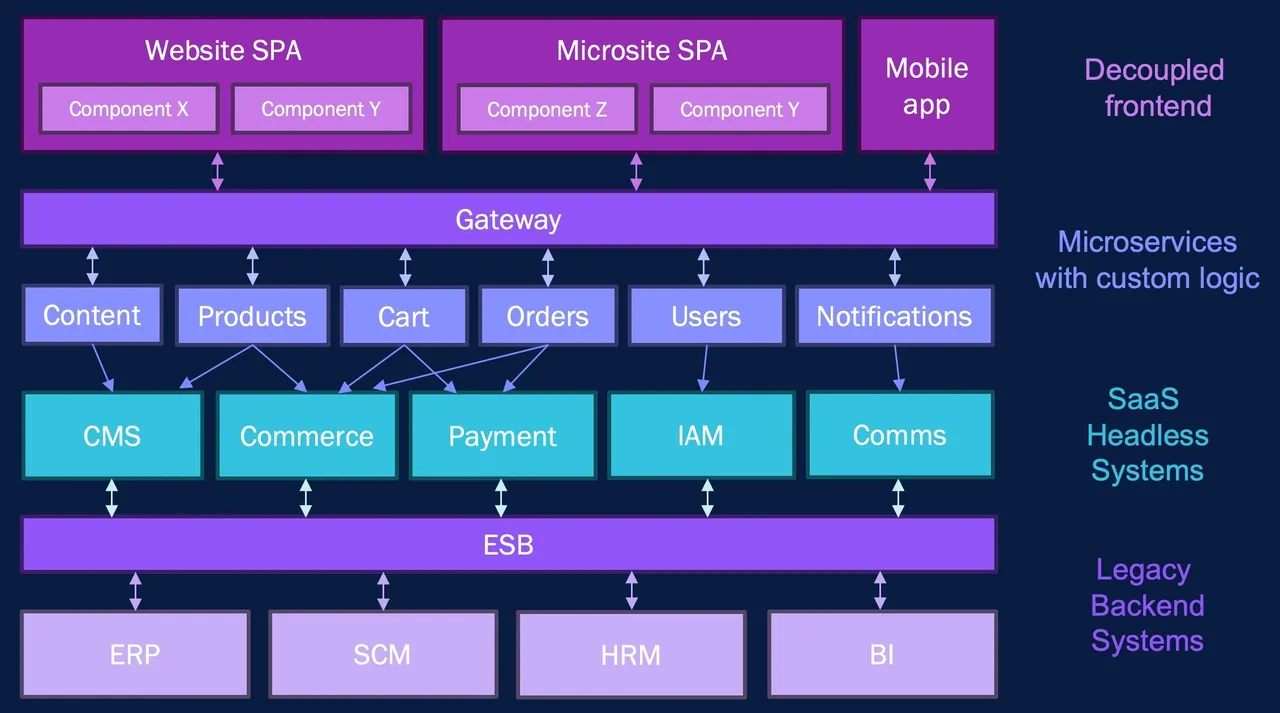Is MACH Architecture The Right Choice For You?
MACH architecture has become a de facto standard for enterprises in recent years. However, there are no silver bullet solutions in IT. Therefore, MACH may be a perfect solution for some companies and situations, while it may be too complex for others.

MACH Foundation
MACH acronym stands for Microservices-based, API-first, Cloud-native, and Headless. Microservices enable building custom logic and integrations independently of backend systems. This means teams can develop and deploy services independently, so a change in one area is possible without affecting others. APIs define interaction points between different frontends, microservices, and backend systems. API-first approach prioritizes defining APIs before implementation, which again minimizes dependencies across teams. Cloud-native implies mostly relying on cloud solutions for storing, hosting, and scaling services. With a headless approach backend applications expose APIs, instead of running an inbuilt graphical user interface. In MACH architectures, the frontend layer is completely decoupled from all API providers. Therefore, not directly dependent on any specific service or backend system.
Monolith vs MACH
Monolith architecture is valid, proven, and still a good fit in many cases. However, the main drivers for switching to MACH are inefficient scaling, bad performance, downtime, increased time to market, vendor lock-in, high license costs, outdated technology, and inability to innovate. MACH can help address all of these, but it's not gonna be a smooth ride for every organization. If the organization is not ready for MACH, instead of leveraging its benefits, it may lead to many complications. Let's look at what factors we should consider before implementing MACH.
Things to Consider
Scalability refers to the ability of a system to perform well under an increased or expanding workload. Even though monolith applications can also auto-scale, MACH enables scaling on more levels. Instead of scaling complete applications, we can scale only affected services, making the scaling process more efficient.
Maintainability describes how quickly and easily we can perform the necessary operations to get systems back to their normal operating state. Monolithic applications can be quite difficult to maintain when complexity increases. However, the same statement can be made for MACH architectures as well. Debugging issues in MACH architectures is usually harder, as the service causing the issue first needs to be traced. Therefore, investments in setting up proper logging and reporting are usually higher.
Flexibility in software engineering means teams can respond effectively to changing customer needs, market demands, and adapting technologies. Monolithic architectures can lead to a strict vendor dependency that limits flexibility. MACH architectures are designed with flexibility in mind, allowing different technology stacks across teams, and easier changes of specific APIs or even complete backend systems.
Adaptability is similar to flexibility but implies anticipating and planning ahead to allow for contingencies. Monolithic applications work better when requirements are standardized. MACH architectures are more suitable for clients with constantly changing requirements, where one system cannot provide a good solution.
Updatability implies the timely rollout of new features and updates after critical vulnerabilities are identified. Monolithic applications can be hard to update when relying on external vendors and their prioritization. Typically, MACH systems are more in control of the client and therefore easier to update. However, the same update may be required in multiple services.
Complexity reflects the number of components that comprise the system and the number of interactions between them. Monoliths are often characterized by large codebases and tightly coupled components that sometimes make the system hard to understand. However, MACH architectures are usually even more complex and take longer to develp. One benefit may be in the lower complexity of each component that is decoupled from others.
Time to market measures the development and release time required to bring a new concept to market. Monoliths are typically deployed as a single unit, making the deployment process time and resource-consuming. Deployments in MACH architectures are usually quicker and easier since every service can be deployed independently. On the other hand, developing a MACH architecture from scratch is more complex and time-consuming.
Innovation is the process of bringing new ideas, methods, products, and services with significant value to life. Monolith applications are harder to refactor and introduce new technology. MACH enables easier innovation by enabling simpler updates to the technology stack and faster development of new services and features.
The costs of implementing and maintaining MACH architectures are usually higher compared to Monoliths. MACH implementations may require lower license costs, but higher infrastructure and development team costs. The complexity of MACH implementations brings more risk. Therefore, organizations usually require strong partners and talents with specialized skills.
MACH Readiness
Organizations with high digital maturity have a much higher success rate in implementing MACH. Digitally mature organizations have a clear digital strategy and vision, are efficient in introducing new technology, and are quick to adapt their processes and ways of working. MACH usually makes sense for organizations with specific business requirements that cannot be met by any existing platform or combination of platforms. Organizations that decide to implement MACH will require a high level of responsibility for controlling and maintaining their systems. By avoiding vendor lock-in, organizations rely less on vendor software and more on internal development and finding the right implementation partners. Also, organizations need more technical resources with up-to-date and diverse technical skills. In the end, MACH is probably not worth the effort unless the organization needs to quickly adapt, innovate, and push new digital solutions and experiences to market.
Summary
To summarize, we recommend MACH architecture to organizations with high digital maturity levels, specific business requirements, high levels of responsibility, capable technical resources, strong alignment between IT and business strategy, and the need to innovate and push new solutions to market fast. In case you identify your organization with these, you will still need strong implementation partners to ensure the success of such a high-complexity project. At Meticulous Digital, we offer frank consultation aligned with your specific goals and requirements. We can help determine the right level of decoupling for your organization.